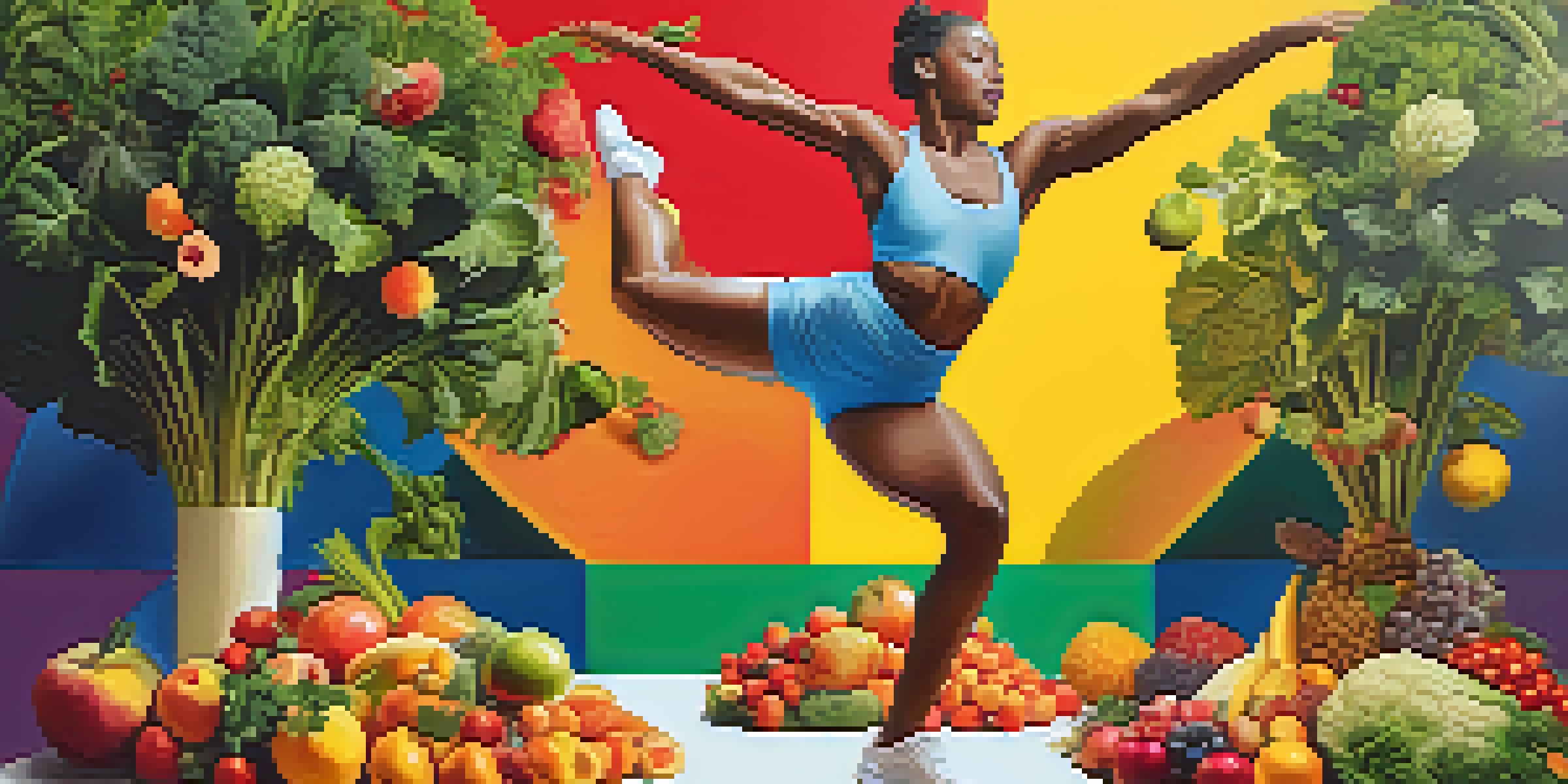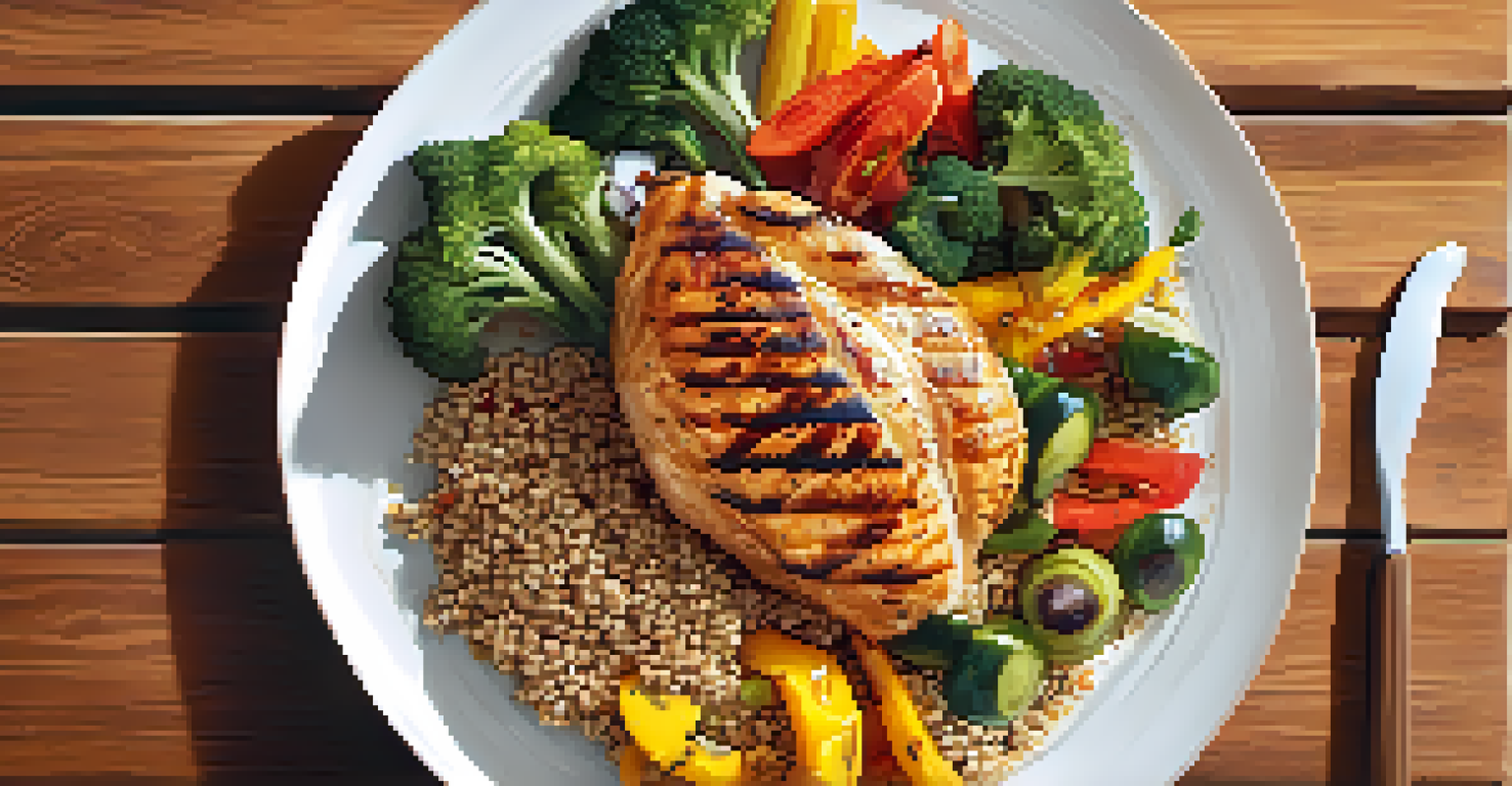The Importance of Balanced Nutrition for Dancer Performance

Understanding Balanced Nutrition for Dancers
Balanced nutrition is the foundation for optimal dancer performance. It involves consuming a variety of foods that provide essential nutrients, including carbohydrates, proteins, fats, vitamins, and minerals. For dancers, this means not just eating enough, but eating the right mix of foods to support their rigorous physical demands.
You are what you eat. So eat well.
Carbohydrates serve as the primary energy source, while proteins help repair and strengthen muscles after intense rehearsals. Healthy fats play a crucial role in hormone regulation and overall health, making them an essential part of a dancer's diet. The key is to create a well-rounded plate that fuels the body effectively.
By understanding the components of balanced nutrition, dancers can make informed choices about what to eat before, during, and after practice. This knowledge empowers them to optimize their energy levels and enhance their performance on stage.
The Role of Carbohydrates in Energy Levels
Carbohydrates are often considered the fuel for dancers, acting as the body's main source of energy. When consumed, carbohydrates break down into glucose, which is used during both aerobic and anaerobic activities. For dancers, having sufficient carbohydrates is crucial for maintaining stamina throughout long rehearsals and performances.

Incorporating whole grains, fruits, and vegetables into meals helps maintain energy levels and supports recovery. For example, a bowl of oatmeal topped with berries can provide lasting energy, while a banana offers a quick boost before practice. This approach ensures that dancers have the energy needed to perform at their best.
Balanced Nutrition Fuels Dancers
A well-rounded diet with the right mix of carbohydrates, proteins, and fats is essential for dancers to optimize their performance.
By prioritizing carbohydrate intake, dancers can avoid fatigue and enhance their ability to execute complex dance routines. This energy management is essential not just for performance but also for enjoying the art of dance without the burden of exhaustion.
The Importance of Protein for Muscle Recovery
Protein is vital for muscle recovery and growth, especially for dancers who engage in physically demanding routines. After intense dancing, muscles experience micro-tears that need to be repaired, and protein plays a critical role in this process. Consuming adequate protein helps rebuild these muscles stronger than before.
Nutrition is not just about eating. It’s about learning to live.
Dancers should aim to include sources of lean protein in their meals, such as chicken, fish, beans, and dairy products. A post-rehearsal smoothie with protein powder and fruit or a chicken salad can be excellent options for recovery. This not only aids in muscle repair but also keeps dancers feeling strong and capable.
Incorporating protein into their diet ensures that dancers can perform at their peak and reduce the risk of injury. By being mindful of their protein intake, dancers enhance their resilience and maintain their physical capabilities over time.
Healthy Fats: An Essential Component of Nutrition
Healthy fats may often get a bad rap, but they are essential for a dancer's overall nutrition. These fats, found in foods like avocados, nuts, seeds, and olive oil, provide a concentrated source of energy. They also support hormone production and nutrient absorption, which are crucial for maintaining a dancer's health and performance.
Incorporating healthy fats into meals can enhance flavor and satisfaction, making a dancer's diet more enjoyable. For instance, drizzling olive oil over vegetables or adding nuts to a yogurt parfait can boost both nutrition and taste. This balance is important for maintaining a positive relationship with food.
Hydration Boosts Performance Quality
Staying hydrated is crucial for dancers, as it helps regulate body functions and enhances endurance and focus during rehearsals.
When dancers embrace healthy fats as part of their balanced diet, they support not only their physical performance but also their mental well-being. This holistic approach to nutrition helps dancers thrive on and off the stage.
Hydration: The Unsung Hero of Performance
While we often focus on food, hydration is just as crucial for dancers' performance. Staying hydrated helps regulate body temperature, maintain joint lubrication, and support overall bodily functions. Dehydration can lead to fatigue, decreased coordination, and impaired concentration, all of which can impact a dancer's ability to perform.
Dancers should aim to drink water consistently throughout the day, not just during practice. Including hydrating foods like fruits and vegetables can also contribute to overall fluid intake. For example, watermelon and cucumbers are great options that provide hydration along with essential nutrients.
By prioritizing hydration, dancers can enhance their endurance and focus during rehearsals and performances. This simple yet often overlooked aspect of nutrition can make a significant difference in their overall performance quality.
Timing: When to Eat for Optimal Performance
Timing meals and snacks around dance practices and performances is key to maximizing energy and focus. It’s important for dancers to eat a balanced meal about two to four hours before dancing to ensure they have enough fuel. A meal rich in carbohydrates, moderate in protein, and low in fat is ideal for optimal performance.
In addition, having a small snack about 30 to 60 minutes before practice can provide a quick energy boost. Options like a piece of fruit or a granola bar can help maintain energy levels during intense sessions. This strategic timing helps dancers avoid feeling sluggish or too full to move freely.
Personalized Nutrition Enhances Dance
Listening to one's body and adjusting nutritional needs enables dancers to optimize their health and improve their overall performance.
By paying attention to when they eat, dancers can enhance their performance and feel their best during practice and shows. This mindful approach to nutrition timing can make a real impact on their overall dance experience.
Listening to Your Body: Personalizing Nutrition
Every dancer's body is unique, and their nutritional needs may vary based on factors like age, intensity of training, and individual metabolism. Learning to listen to one’s body is crucial in determining what works best for each dancer. This might mean adjusting portion sizes or trying different food combinations until finding the right balance.
Dancers should pay attention to how certain foods make them feel during practice. For example, if a certain meal leads to sluggishness or discomfort, it may be time to reassess that choice. It’s all about finding what fuels their individual performance and enhances their dancing experience.

By embracing personalized nutrition, dancers empower themselves to optimize their health and performance. This self-awareness not only improves their dance but also promotes a positive relationship with food and their bodies.